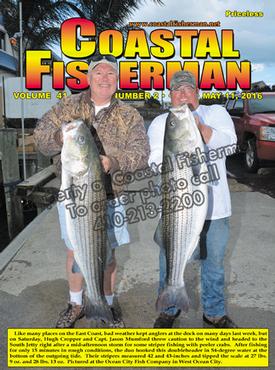


Article by Capt. Mark Sampson
 Over the next few weeks, a lot of anglers will point their boats offshore toward shark infested waters. In the process, many will scour navigation and water temperature charts that they hope will help put them in the flight path of enough sharks to keep them busy during their early season offshore fishing trips. Although blue sharks will likely account for most of the early season action, many anglers will eagerly look forward to setting their hooks into some of the many mako sharks that wander their way into Delmarva’s waters this time each season.
Over the next few weeks, a lot of anglers will point their boats offshore toward shark infested waters. In the process, many will scour navigation and water temperature charts that they hope will help put them in the flight path of enough sharks to keep them busy during their early season offshore fishing trips. Although blue sharks will likely account for most of the early season action, many anglers will eagerly look forward to setting their hooks into some of the many mako sharks that wander their way into Delmarva’s waters this time each season.
I used the term “wander” in describing the mako’s movements because it’s a more accurate way of describing the reasons and the manner in which they find their way into the waters off our coast each spring, and kind of what they do when they’re here. Contrary to what many fishermen like to believe, makos don’t move into or through our area in a defined wave of fish like many other species do. They don’t “migrate” up to the north then back down to the south in the fall like schools of striped bass or many other fish species. Although there is still a lot to be learned about why makos do what the do and go where they go, right now we’re beginning to realize that at least some of these sharks just sort of meander around the ocean in no logical or predictable pattern. At any time, an individual mako could be found very close to the coastline, out in the middle of the ocean or anywhere in between.
We know this in part because of a mako tagging study that has been conducted over the last three years off the coast of Delmarva. In order to track their movements, mako sharks have been caught, fitted with satellite SPOT tags and then released. Thereafter, every time the shark’s dorsal fin breaks the surface the tag transmits location information to satellites overhead that the scientists are able to access each day. Since mako sharks tend to spend a lot of time at the surface, a very detailed travel history can usually be plotted out for each tagged shark. The length of the plot is determined by the life of the tag’s battery, which can be 1 to 2 years.
Since 2013, a total of 22 makos have been tagged off Delmarva with satellite SPOT tags and if you look at the tracks of each shark it’s not hard to determine that their travels appear to be mostly random. The makos were caught 20 to 40 miles off Ocean City in late May, and after being tagged, some elected to stay in the general area while others immediately headed many hundreds of miles offshore. As most would expect, some of the makos left our waters and worked their way north, but some of them actually headed south to waters off Virginia and North Carolina.
In 2013, most of the makos left Delmarva’s Continental Shelf waters and ended up off Canada and the Grand Banks, but in 2014 and 2015 they tended to stay more off the US coast, both on and off the Continental Shelf, but seldom far from the edge except for a few sharks that ended up wandering surprisingly close to the coastline, particularly off Long Island. Even during the last couple of winters the makos tended to stay up on the shelf rather than move farther out to Gulf Stream waters where we would “think” there would be a better environment with more food.
Then there have been the real “travelers” that moved way out to the middle of the ocean and one that even went beyond the mid-Atlantic ridge. A few of these sharks found their way down to the equator and a couple seemed to make a effort to visit the waters around Bermuda along the way.
The mako study continues this year with the first tagging trip scheduled for May 16th. Hopefully, by the end of the month there will be another dozen or more new makos swimming about that sport high-tech transmitters on their dorsal fins as they talk to the satellites each day. Local anglers can assist in this research in two ways. First, if they happen to catch a mako that has a transmitter attached to its dorsal fin they should release the shark so that it can continue to provide valuable travel data to those doing the research.
Second, if anyone actually wants to be a part of this study they should contact me at BigSharks.com or 410-726-7946. During the last week of May we still have a few seats left on the tagging boat (Fish Finder) for those interested in coming along to help out as anglers/helpers/sponsors of this unique research program.
A link to the daily tracks of all the makos tagged in the last three years can be found on my BigSharks.com website. From the right side of my homepage click on the “Shark Tracking” tab then click “Go to the tracking site >> here” which will take you to the “Choose a Project Page” where you should select option #3 “W.North Atlantic.” Then select any of the sharks on the right side of the screen to follow.
Capt. Mark Sampson is an outdoor writer and captain of the charter boat, “Fish Finder”, docked at the Ocean City Fishing Center.